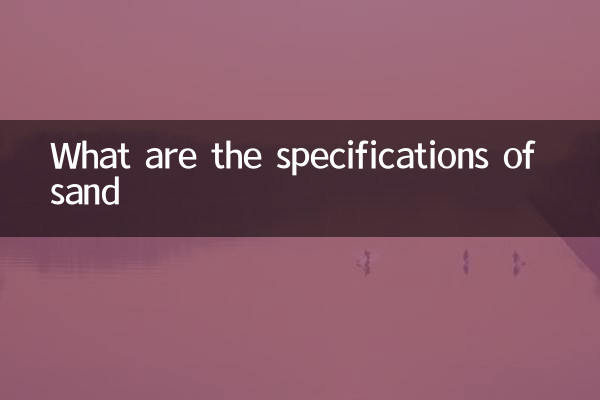What are the specifications of sand
As an indispensable material in construction engineering and industrial manufacturing, sand has a wide variety of specifications and uses. This article will combine popular topics and hot contents on the entire network for the past 10 days to introduce the specifications, classifications and application scenarios of sand to you in detail, helping you better understand this basic building material.
1. Basic classification of sand

Sand can be divided into two categories: natural sand and artificial sand according to its source and particle size. Natural sand includes river sand, sea sand and mountain sand, while artificial sand is made of rocks after crushing. The following are the main categories and characteristics of sand:
| type | source | Features |
|---|---|---|
| River sand | River erosion sediment | Round particles and low mud content, suitable for construction |
| Sea sand | Ocean Sedimentation | High salt content, need to be desalted |
| Mountain sand | Mountain weathering | There are many edges and angles, and the mud content is high |
| Artificial sand | Rocks broken | Sharp particles, high strength |
2. Sand specifications
The specifications of sand are usually divided according to the particle size, and different specifications of sand are suitable for different engineering needs. Here are the common sand specifications and their uses:
| Specification name | Particle size range (mm) | Main uses |
|---|---|---|
| Extra fine sand | 0.15-0.25 | Decorative mortar, putty |
| Fine sand | 0.25-0.35 | Masonry mortar, plastering |
| Middle sand | 0.35-0.5 | Concrete, masonry |
| coarse sand | 0.5-1.0 | Concrete, roadbed |
| Extra coarse sand | 1.0-2.0 | Roadbed, filter layer |
3. Sand quality indicators
The quality of sand directly affects the quality and safety of the project. Here are a few key indicators for measuring sand quality:
| Metric Name | Standard requirements | Detection method |
|---|---|---|
| Mud content | ≤3% (for concrete) | Washing method |
| Fine Module | 2.3-3.0 (Medium Sand) | Screening method |
| Ruggedness | ≤8% (for concrete) | Sodium sulfate solution method |
| Chloride ion content | ≤0.02% (reinforced concrete) | Chemical analysis method |
4. Recent hot topics: Sand resources are short
In the past 10 days, discussions on global sand resources have once again become hot topics. According to a report by the United Nations Environment Programme, the world consumes about 40-50 billion tons of sand every year, and over-exploitation has caused ecological environment damage in many places. The following are recent hot topics:
1.Vietnam restricts river sand exports: The Vietnamese government announced that it will further restrict river sand exports to protect domestic resources.
2.Research and development of alternative materials: Many companies have begun to study the use of construction waste, industrial waste, etc. to make recycled sand to alleviate resource pressure.
3.Breakthrough in sea sand desalination technology: my country's scientific research team has developed a new sea sand desalination process, which can reduce the treatment cost by 30%.
5. How to choose the right sand
When choosing sand, you need to consider project requirements, cost budget and environmental protection factors:
1.Construction Engineering: Preferred to medium or coarse sand to ensure the strength of the concrete.
2.Decoration Engineering: Choose extra fine sand or water-washed sand to ensure surface smoothness.
3.Environmental considerations: When conditions permit, machined or recycled sand is preferred.
4.Cost control: Reasonably match sand of different specifications to reduce costs while ensuring quality.
6. Future development trends
With the improvement of environmental protection requirements and technological progress, the sand industry will show the following development trends:
1.The proportion of machine sand increases: It is estimated that by 2025, the proportion of machined sand in construction sand will exceed 60%.
2.Complete standard system: Countries will formulate stricter standards for sand mining and use.
3.Recycling acceleration: Construction waste sand making technology will be widely used.
By understanding the specifications and quality standards of sand, we can select and use this important building material more scientifically while contributing to the protection of the environment.

check the details

check the details